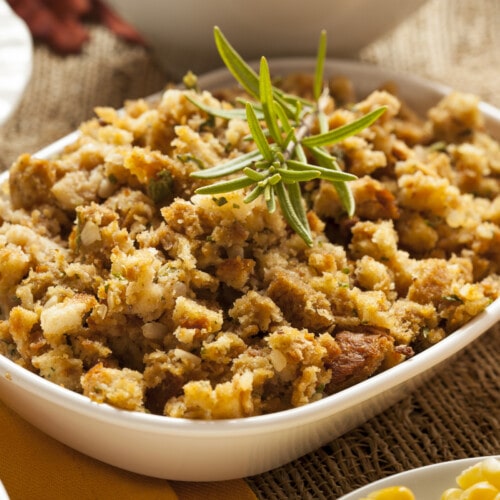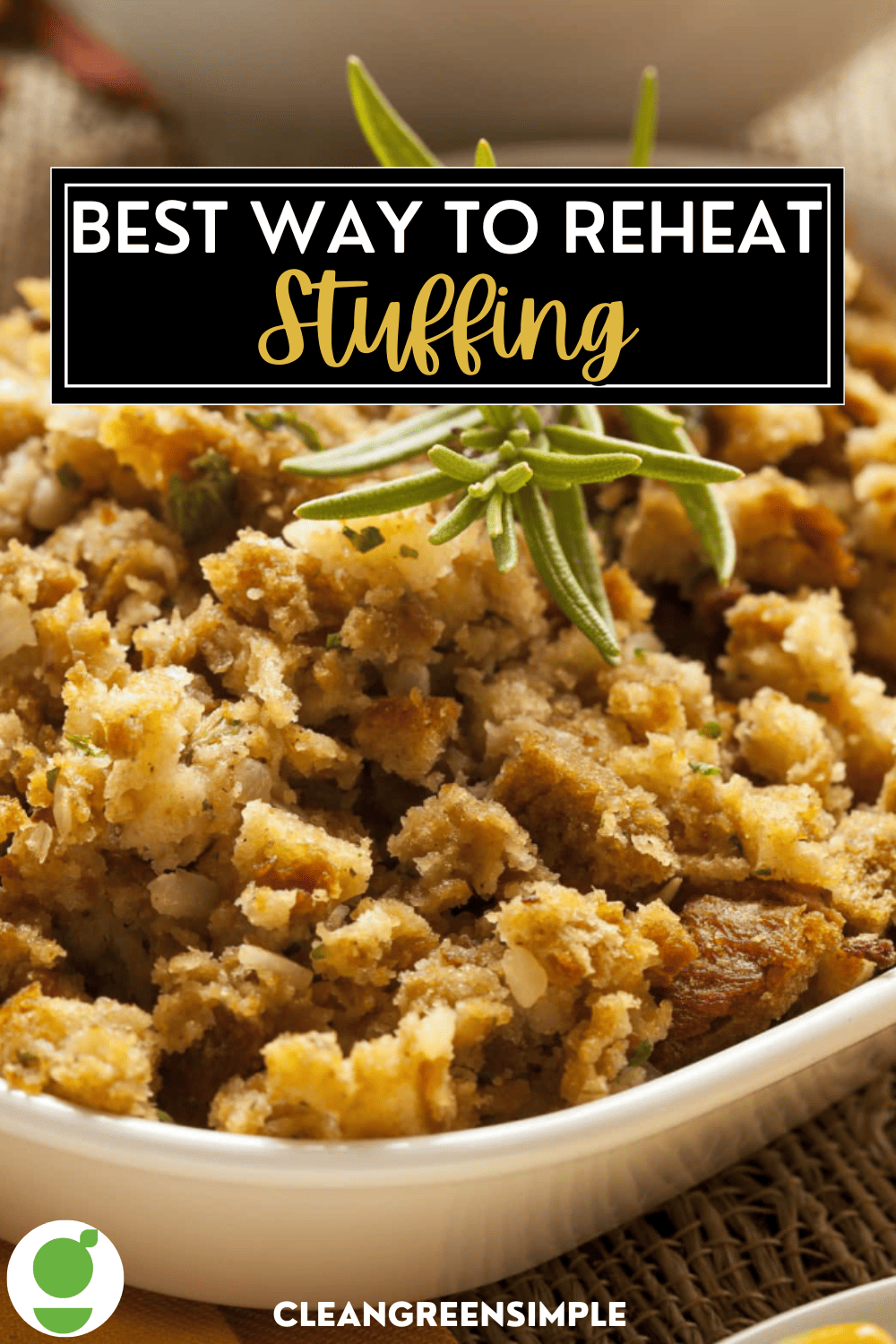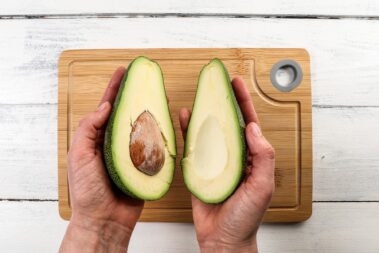Having stuffing leftover after Thanksgiving is a good problem to have. So long as you know how to reheat this holiday favorite without drying it out, that is.
So, how do you reheat stuffing? The best way to reheat stuffing so it doesn’t get dried out is on the stovetop. Add a little oil and broth to a pan, then add the stuffing and heat on medium-low until warmed through.
For more details on this method for reheating stuffing as well as two more great ways to continue enjoying this Thanksgiving side for days on end, keep reading.
Table of Contents
3 Ways to Reheat Stuffing
The key to reheating stuffing is to add extra moisture to replace what is lost in the storage and heating process. This is true whether you are reheating your stuffing on the stovetop, in the oven, or in the microwave.
1. On the Stovetop
The stovetop is my preferred method for reheating stuffing because it is relatively quick, easy, and energy-efficient. Plus, with this method, you can heat any amount of stuffing you need. It’s especially useful if you are only heating enough for yourself.
On the downside, this method does require some work, mostly in the form of constant stirring to prevent the bottom from getting overcooked. But overall, this is a fairly simple method and it only takes about 5 minutes.
To reheat your stuffing on the stovetop:
- Add a drizzle of oil or a spoonful of butter or vegan butter to the bottom of a small pan or pot and heat it on medium.
- Once the oil begins to heat, add a small amount of broth. For a single serving of stuffing, you’ll want to start with just one or two tablespoons of broth. For larger amounts, add up to ½ cup.
- Add your stuffing to the heated broth and oil and stir.
- Cover and heat on medium-low for 3 to 5 minutes, stirring occasionally until heated through. Aim for 165 degrees or higher for the internal temperature.
Adding broth and fat to the pan before reheating will help replace the moisture that has already been lost during storage and that will continue to be lost during reheating. It will also add extra flavor to your stuffing and, likely, make it even tastier than it was the first time around!
2. In the Oven
The oven is another great way to reheat stuffing, especially if you like your stuffing crispy around the edges.
Reheating leftovers in the oven gives you better control of the temperature and helps avoid over-drying. This is why this method is our top choice for reheating mashed potatoes.
But using the oven does take quite a bit longer than the other two methods listed here and is best reserved for large portions considering the amount of energy used. If you are doing a second thanksgiving dinner using leftovers or if you cooked your stuffing a day early, this is the best way to reheat it, hands down.
To reheat your stuffing in the oven:
- Spread your stuffing evenly across a glass baking casserole or any oven-safe dish.
- Add melted butter, vegan butter, or oil (about 1 teaspoon per serving) to broth (1 to 2 tablespoons per serving) and mix well then drizzle over your stuffing. If your stuffing doesn’t look too dried out, you can skip this step.
- Preheat your oven to 350 degrees.
- Cover the baking dish with aluminum foil and bake for 30 minutes.
- If you like crispy stuffing, remove the foil after 30 minutes and bake for an additional 10 minutes or until brown and crispy on the top.
If you do go the crisping route, I recommend adding the oil and broth in the beginning regardless of if the stuffing looks moist or not. Baking the stuffing without the cover will dry it out even more than normal, so adding that extra moisture is a key step to serving up a tasty dish.
3. In the Microwave
The microwave, as usual, is my least favorite route for reheating. But, if you are only reheating a small portion and are crunched for time, you just can’t beat the convenience a microwave provides. Plus, this is by far the most energy-efficient way to reheat most leftovers.
You won’t get crispy stuffing using this method, but, if you’re careful about balancing your moisture, you can get deliciously moist stuffing that tastes great even if the texture isn’t perfect.
To reheat stuffing in the microwave:
- Place the stuffing in a microwaveable safe casserole dish or container.
- Mix some oil, melted butter, or vegan butter (about 1 teaspoon per serving) with broth (about 1 tablespoon per serving) and add it to the stuffing. Stir well.
- Cover well with wax or parchment paper and cook on high heat for 1 minute.
- Take out and stir, and then return to the microwave for another 1 to 2 minutes. Continue to stir after each minute and cook until heated through.
Tread on the side of caution with your added oil and broth. If you put too much in, your stuffing will become mushy as it cooks. Start with just a dash of each and add more as it cooks if needed.
How to Reheat Frozen Stuffing
Whether you’ve frozen leftovers to enjoy Thanksgiving in spring or pre-made your stuffing far in advance of the holidays, the process of cooking frozen stuffing is the same.
- Start by transferring the frozen stuffing into an oven-proof container. This may require a little thawing, but there is no reason to waste time thawing the entire block.
- Cover the dish with foil.
- Place the container in a preheated oven at 350 degrees.
- Cook for up to an hour or until the stuffing is heated through.
- Remove the foil and continue to cook for about 15 minutes until the top browns.
If you followed our tips from above and only added half the stock when pre-making your stuffing, don’t forget to mix in the rest now. This is best done after the stuffing has fully thawed and is just beginning to warm up, or about 20 minutes into the process.
When reheating already-cooked frozen stuffing, adding a little extra butter and stock can be helpful to keep it from drying out. Add about 1 teaspoon of butter or oil and 1 to 2 tbsp of broth per serving of stuffing being reheated. Mix the butter and broth and drizzle them over the stuffing before putting it in the oven.
Alternative: Make Your Stuffing In Advance
Stuffing is one of the most time-consuming side dishes to make for Thanksgiving. Luckily, it is possible to make this dish early and cook it the day of to help take some work off your plate.
To do this, simply mix up the recipe as normal (try this stuffing recipe if you don’t already have a favorite) and place everything in a baking oven-safe dish so it’s ready to cook when the time comes. Make sure you allow the base ingredients to cool before adding any toppings that are likely to melt.
If you need to make your stuffing more than one day in advance you can always freeze it. Use a ziplock bag or container with saran wrap and a tight-fitting lid to store it. Stuffing holds up well in the freezer for up to 6 months, so feel free to start planning your Thanksgiving dinner in May next year!
Tips for making stuffing ahead of time:
- Dry your bread in the oven instead of on the counter. Drying your bread pieces in the oven at 250 degrees for about 90 minutes will better remove moisture for firmer stuffing tomorrow.
- Don’t go overboard with moist ingredients. Overloading your stuffing with celery, apples, onions, and other vegetables can introduce extra moisture that will leach into the bread as it sits. To avoid this unaccounted-for liquid, go light on the produce or wait to mix it in until you’re ready to cook the stuffing.
- Add the stock in stages. A little veggie stock in your pre-made stuffing helps introduce a lot of flavor into the bread. But too much will turn it into mush before you cook it. We recommend adding half your stock upfront and then saving the rest to mix in right before you pop it in the oven.
FAQ
Can you refrigerate uncooked stuffing?
Yes, you can absolutely refrigerate uncooked vegan stuffing before cooking it. While many caution against refrigerating uncooked stuffing if it has meat in it, you’re probably safe to do so as long as the stuffing goes immediately into the fridge and is cooked within 24 hours of being prepared.
How long does leftover stuffing last?
Like most leftovers, it’s recommended that you eat leftover stuffing within 3 to 5 days of when it was first cooked. Vegan stuffing will likely last longer, up to 5 to 7 days if properly stored in the refrigerator in an airtight container. Be sure to reheat your stuffing to at least 165 degrees before serving it up to be enjoyed.
Do you reheat stuffing covered or uncovered?
Yes, you should cover your stuffing with tin foil when reheating it in the oven. Stuffing reheated on the stovetop and in the microwave will also benefit from being covered up while it cooks.
What to Serve with Leftover Stuffing
Want to turn your leftover stuffing into a full meal? Try these easy yet awesome vegan Thanksgiving dishes that pair perfectly with fresh or reheated stuffing.
- Wild Rice Stuffed Acorn Squash – This deliciously healthy stuffed squash recipe is surprisingly simple to make.
- Sweet Potato Casserole and Pecan Crumble – Decadent dessert? Super easy side dish? That’s up to you.
- Mashed Potatoes and Mushroom Gravy – It wouldn’t be a holiday meal without some mashed potatoes.
- Easy Holiday Cranberry Sauce – This tangy, fresh, homemade cranberry sauce is the perfect complement to savory stuffing.
- Vegan Sweet Potato Pie – Why not round out your Thanksgiving part 2 (or 3 or 4) with this decadently delicious sweet potato pie?
Looking for more holiday inspiration or helpful kitchen tips? Be sure to sign up for our newsletter so you don’t miss out on any new clean, green content.
The Best Way to Reheat Stuffing
Reheating stuffing is all about controlling the moisture. The easiest way to do this is to add some extra butter or oil and heat it on the stove or pop it in the oven. In a pinch, the microwave will work too, but it takes extra work to keep your stuffing from drying out.
What is your favorite method for reheating Thanksgiving staples like stuffing? Let us know by posting in the comments section below.

The Best Way to Reheat Stuffing
Ingredients
- 1 batch leftover stuffing
- oil or plant-based butter
- vegetable broth
Instructions
- Add a drizzle of oil or a spoonful of butter or vegan butter to the bottom of a small pan or pot and heat it on medium.
- Once the oil begins to heat, add a small amount of broth. I prefer a bit of salt, so go for the regular broth if using a carton or can brand. For a single serving of stuffing, you’ll want to start with just one or two tablespoons of broth. For larger amounts, add up to ½ cup.
- Add your stuffing to the heated broth and oil and stir.
- Cover and heat on medium-low for 3 to 5 minutes, stirring occasionally until heated through. Aim for 165 degrees or higher for the internal temperature.








